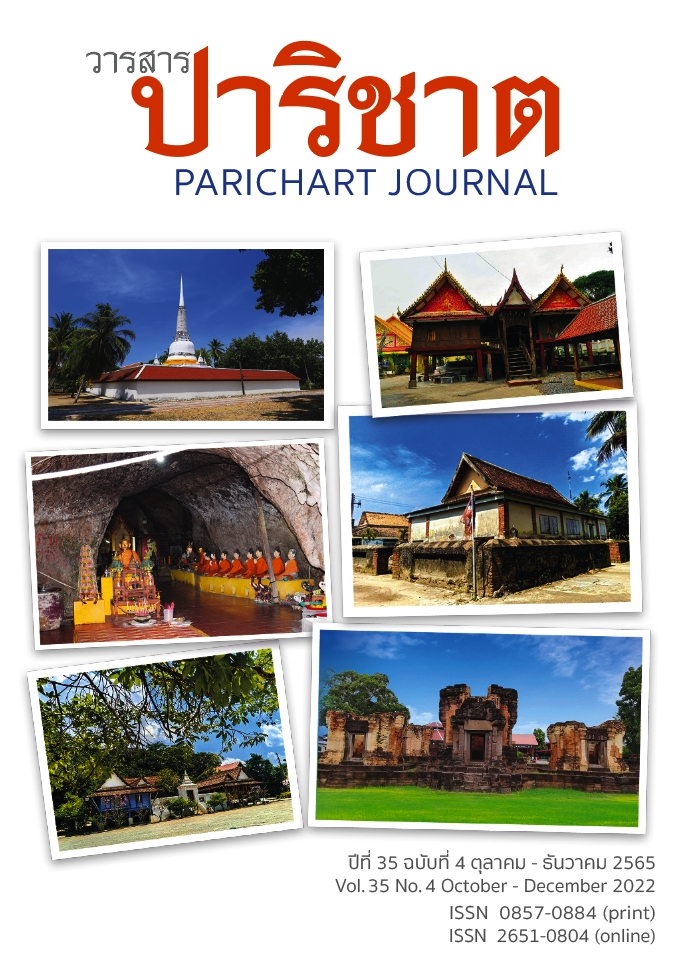Survey of Information Signage in Community Tourism Destinations
Main Article Content
Abstract
The signage in tourist destinations has played important roles in many aspects including way finding, providing information, and being a physical element which create identity of the tourism destination. This research aimed to survey, categorize, and analyze the signage in situ in community tourism destinations administrated by the Designated Areas for Sustainable Tourism Administration (Public Organization) or DASTA. The empirical data were collected from nine communities, and analyzed based on the typology of existing signage using different criteria, including quality of cultural heritage, signage owners or sponsors, signage appearance, and conformity with surroundings. The findings from the survey have shown that the majority of the signage has been built and managed by community members, and thus may not necessarily conform with the environment of each community. The design of the signage were variety but the highest group from survey was design referred to social events. The research show that the need on improving signage management and providing related education for leaders of tourism communities.
Article Details

This work is licensed under a Creative Commons Attribution-NonCommercial-NoDerivatives 4.0 International License.
References
Falk, J. H., & Dierking, L. (1992). The museum experience. Whalesback Books.
Getz, D. (2008). Event tourism: Definition, evolution, and research. Tourism management, 29(3), 403-428.
Chang, H. (2013). “Wayfinding strategies and tourist anxiety in unfamiliar destinations” Tourism Geographies, 15(3), 529-550.
Stone, C., & Vaugeois, N. (2007). Welcome! A manual to enhance community signage and visitor experience. Tourism Research Innovation Project (TRIP). https://www.trip-project.ca.
Calori, C. (2007). Signage and wayfinding design. John Wiley & Sons.
Maneeroj, N. (2017). Community based tourism management. International Thai Tourism Journal, 13(2), 25-46. (in Thai).
Imbert-Bouchard Ribera, D. (2021), "The use of signage as a tool for social integration in tourist cities: examples of relevant cases in Catalonia", International Journal of Tourism Cities, 7(2). 294-312. https://doi.org/10.1108/IJTC-03-2020-0037
Dan, P. (2005). Tourism, tourist experience and signs: A Review of related studies. Tourism Science. 6. http://en.cnki.com.cn/Article_en/CJFDTOTAL-LUYX200506000.htm.
Department of Tourism. (2020). Tourism facilities in prototype community tourism destination project. http://www.dla.go.th/work/proto.pdf (in Thai)
National Tourism Policy Committee. (2016). Criteria for Thailand’s community-based tourism development. https://opendata.data.go.th/en/dataset/item_db41976b-78b5-4c3d-b13d-223414de8c2b (in Thai)
Patanachan, J. (2020). Community-based tourism management case study Wat Tarn Community Pa-Mok District Ang-Thong Province. {Master Thesis, Silpakorn University] Graduate School, Silpakorn University. Retrieved on April 20, 2021. from: http://ithesis-ir.su.ac.th/dspace/bitstream/123456789/2559/1/58112303.pdf
DASTA. (2017). CBT How to become sustainable?. https://tis.dasta.or.th/dastaknowledge/wp-content/uploads/2019/12/CBT-ทำอย่างไรให้ยั่งยืนไทย.pdf. (in Thai).
Office of Natural Resources and Environmental Policy and Planning (ONEP). (n.d.). Handbook for rapid method for architectural survey in surroundings. The Conservation of Cultural Environment Program. (in Thai).
Yodsurang, P. (2019). “Threats affecting physical characteristics of the old waterfront communities in the chao phraya river basin”. Journal of the Faculty of Architecture King Mongkut's Institute of Technology Ladkrabang, 28(1), 21-34. (in Thai).
Yodsurang, P., & Wiyati, W. (2022). "Cultural heritage interpretation of old home and historic house in the old town of nakhon”. Journal of Architectural/Planning Research and Studies, 19(2), 39-54. (in Thai).
Hua, S. (2010). World heritage classification and related Issues—A case study of the convention concerning the protection of the world cultural and natural heritage. Procedia - Social and Behavioral Sciences, 2(5), 6954-6961. doi:https://doi.org/10.1016/j.sbspro.2010.05.048.
Kurniawan, H., Salim, A., Suhartanto, H., & Hasibuan, Z. A. (2011, May). E-cultural heritage and natural history framework: an integrated approach to digital preservation. In International Conference on Telecommunication Technology and Applications (IACSIT) (pp. 177-182).
Petti, L., Trillo, C., & Makore, B. N. (2020). Cultural heritage and sustainable development targets: a possible harmonisation? insights from the european perspective. Sustainability, 12(3). doi:https://doi.org/10.3390/su12030926.
UNESCO (n.d.). The criteria for selection. https://whc.unesco.org/en/criteria/.
Sirisrisak, T. (2007). Historic urban Landscape: Interpretation and Presentation of the Image of the City. Paper presented at the ICOMOS Thailand International Symposium 2007, Bangkok, Thailand.
Department of Tourism. (2020). Standard of Signage Design and Construction for Natural and Vernacular Tourist Destination. https://drive.google.com/drive/folders/1CVIamCxiY1KhYQnVofBITnHLpyGlzX6x. (in Thai)
Stapitananda, L. (1997). Design Techniques. Chulalongkorn University Press.
DASTA. (2018). Community Tour with DASTA people. https://tis.dasta.or.th/dastaknowledge/localcommunity/ (in Thai).


